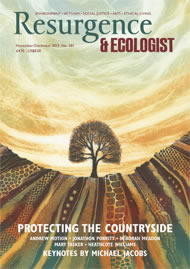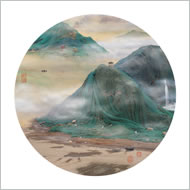Waterfalls cascade silently over green-furnished mountainsides. Minute figures and winsome pagodas are dwarfed by lofty landscapes, cloaked in atmospheric mist. But this world is not as it seems. Beneath these bucolic Chinese landscapes lies a powerful memorandum.
First appearances are certainly not ones to go by when it comes to the mastery of digital deception in Chinese artist Yao Lu’s work. The poetic allure of his landscapes is suddenly unsettling. On closer inspection, a meandering river morphs into a road, cranes and factories churning out poisonous smoke pepper the horizon, whilst people don construction helmets, and plastic bags hang off tree branches. The mountains themselves are masses of rubble and rubbish.
Born and based in Beijing, Yao Lu is garnering international acclaim for his imitations of traditional Chinese literati landscapes. Scroll-like, fanned or circular, his New Landscapes mimic the mountain paintings of the antiquated Song Dynasty, down to the delicate detail of traditional red signature stamps and collection seals known as chop marks. Through re-assembling and re-editing photographic imagery, he superimposes figures, buildings and trees, along with various bodies of water, mist and snow effects, onto mounds of concealed industrial waste.
Dramatic changes in China’s recent history include extensive construction and as a result, a dramatic transformation of the physical environment. A by-product of this construction has effectively colonised the visual landscape of Beijing – mounds of cloth-covered debris. These piles of rubbish – blanketed by green industrial dustproof cloth – have become a ubiquitous phenomenon representing icons of capitalism and power, modernity and progression: a troubling emblem of contemporary China.
In recognising the potential aesthetic symbolism of the green-netted industrial cloth, Yao Lu criticises economically driven policies that sacrifice tradition and Nature in the race for modernity. The dustproof cloth is used to mask rubbish and conceal the ugliness beneath – a cosmetic cloak necessary for veiling a less attractive reality. Gaps in the cloth suggest a tension between concealment and exposure, as if the Earth underneath were about to break the superficial harmony of the surface. Unveiling the cloth would be to expose the materials of reality, this moment of exposure a shocking revelation.
The notion of a photograph being an unadulterated document of truth has long since been buried, but here is the documentation of a different kind of truth. Touching upon the tradition of ‘the sublime’ in art – with the forces of construction replacing those of Nature – Yao Lu’s digital manipulation imitates our manipulation of the landscape, and our manipulation of Nature. And through reconstructing the traditional Chinese landscape, he reflects on humankind’s changing relationship with the Earth as well as our altering perceptions of reality.
Inspired by genuine fear – fear for the planet and its resources, fear that Nature as we know it will eventually only be experienced through pictures of a past world – Yao Lu’s imagery is lyrically mournful. The strength of its poignancy lies in disappointment and nostalgia, more than anger and defiance. Yao Lu expresses his aspirations in a statement about his work: “I want the world to be able to make a benign transformation. People must protect the environment. This work implies that the world should become more and more harmonious.”
Yao Lu is currently working on a new body of work, which will be concerned with population and survival, and although industrial waste will not be its main model, the work will continue to be “concerned for the living environment of humankind, and for the protection of culture, in particular the protection of traditional culture”.
Simultaneously both real and fictional, Yao Lu’s digital montages merge coexistent realities to produce subtly unnerving imagery, tapping at the door of our conscience. With seamless digital imaging matched by poignant visual context, he communicates “a longing for the disappearing”, superimposing a revered past onto a troubled present and uncertain future. Using the language of tradition to reconnect with reality, Yao Lu’s landscapes communicate with the present and contemplate the future.
Yao Lu was shortlisted for the 2nd Prix Pictet global award in photography and sustainability. www.prixpictet.com








